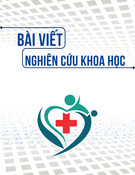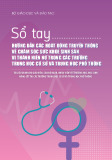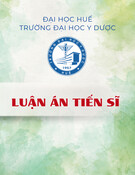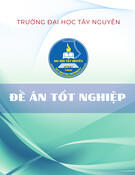
68
Một số yếu tố nguy cơ xuất huyết trong não thất ở trẻ đẻ non tại Bệnh viện
Phụ sản Trung ương
Hà Thị Lương1*, Lê Minh Trác1, Hoàng Thị Vân1
1Bệnh viện Phụ sản Trung ương
Tóm tắt
Mục tiêu:
Đánh giá tỷ lệ xuất huyết trong não thất (XHTNT) và nhận xét một số yếu tố nguy cơ xuất huyết trong não
thất ở trẻ đẻ non.
Đối tượng và phương pháp nghiên cứu:
Nghiên cứu mô tả cắt ngang 300 bệnh nhân đẻ non tại Bệnh viện Phụ sản
Trung ương từ tháng 9/2023 đến tháng 3/2024.
Kết quả:
Siêu âm thóp 300 bệnh nhân có 49 bệnh nhân xuất huyết trong não thất chiếm tỷ lệ 16,3%, Mức độ XHTNT
độ 1: 59,2%, độ 2: 18,4%, độ 3: 12,2%, độ 4: 10,2%. Trẻ dưới 28 tuần thai (52,6%), trẻ dưới 1000 g (32,8%). Siêu âm thóp
phát hiện 89,8% xuất huyết trong 7 ngày đầu. Tiêm steroid trước sinh giảm nguy cơ XHTNT (OR = 0,48, p = 0,043). Một
số yếu tố tăng nguy cơ XHTNT: apgar < 7 điểm, tuổi thai < 32 tuần, cân nặng < 1500g, hỗ trợ thở máy, hạ nhiệt độ, pH
< 7,2, BE < -10, PaCO2 > 55 mmHg, bệnh màng trong, chảy máu phổi, nhiễm khuẩn sơ sinh, còn ống động mạch, tiêm
bicarbonat. Phân tích đa biến: apgar < 7 điểm (OR = 7,5, p = 0,01), tuổi thai < 32 tuần (OR = 5,0; p = 0,02), hỗ trợ thở
máy (OR = 8,7; p = 0,03), pH < 7,2 (OR = 13,2; p < 0,001), BE < -10 (OR = 13,1; p < 0,001), PaCO2 > 55 mmHg (OR = 3,2;
p = 0,002), còn ống động mạch (OR = 3,2; p = 0,002) làm tăng nguy cơ xuất huyết trong não thất.
Kết luận:
Tỷ lệ XHTNT ở trẻ đẻ non khá phổ biến 16,3%, đặc biệt ở trẻ đẻ non dưới 28 tuần và dưới 1000g. Tiêm steroid
trước sinh giảm nguy cơ XHTNT. Có nhiều yếu tố nguy cơ làm tăng tỷ lệ XHTNT. Phân tích đa biến: apgar < 7 điểm, tuổi
thai < 32 tuần, hỗ trợ thở máy, pH < 7,2, BE < -10, PaCO2 > 55 mmHg, còn ống động mạch làm tăng nguy cơ XHTNT.
Từ khóa:
xuất huyết trong não thất, non tháng, các yếu tố nguy cơ.
Risk factors for intraventricular hemorrhage in preterm newborns at the
National Hospital of Obstetrics and Gynecology
Ha Thi Luong1*, Le Minh Trac1, Hoang Thi Van1
1 National Hospital of Obstetrics and Gynecology
Abstract
Objectives:
To assess the rate of intraventricular hemorrhage (IVH) and comment on some risk factors for IVH in
preterm newborns.
Subjects and methods:
Cross-sectional descriptive study of 300 preterm newborns at the Nationnal Hospital of
Obstetrics and Gynecology from September 2023 to March 2024.
Results:
Cranial ultrasound 300 patients included 49 patients with intraventricular hemorrhage 16.3%, the
hemorrhage grading rate: level 1 (59.2%), level 2 (18.4%), level 3 (12.2%), level 4 (10.2%), infants < 28 weeks (52.6%),
infants < 1000g (32.8%). Cranial ultrasound detected hemorrhage 89.8% of cases in the first 7 days. Antenatal
steroids reduce the risk of IVH. Risk factors: Apgar score < 7 point, gestational age < 32 weeks, birth weight < 1500g,
invasive ventilator support, hypothermia, pH < 7.2, BE < -10, PaCO2 > 55 mmHg, respiratory distress syndrome,
pulmonary hemorrhage, neonatal sepsis, patent ductus arterious, bicarbonate IV. Multivariate analysisrevealed
that Apgar score < 7 point (OR = 7.5; p = 0.01), GA < 32 weeks (OR = 5.0; p = 0.02), invasive ventilator support (OR =
8.7; p = 0.03), pH < 7.2 (OR = 13.2; p = 0.01), BE <- 10 (OR = 13.1; p < 0.001), PaCO2 > 55 mmHg (OR = 3.2; p = 0.002),
patent ductus arterious (OR = 3.2; p = 0.002) were associated with an increased risk of IVH
.
Conclusions:
The rate of IVH in premature infants is quite common at 16.3%, especially in premature infants under 28
weeks and under 1000g. Antenatal steroid reduce the risk of IVH. There are many risk factors that increase the rate
doi: 10.46755/vjog.2024.4.1764
Tác giả liên hệ (Corresponding author): Hà Thị Lương, email: haluong207@gmail.com
Nhận bài (received): 20/9/2024 - Chấp nhận đăng (accepted): 04/10/2024
Hà Thị Lương và cs. Tạp chí Phụ sản 2024; 22(4):68-72.
doi: 10.46755/vjog.2024.4.1764
SẢN KHOA - SƠ SINH








































